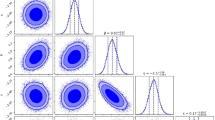Abstract
We present a mechanical model that identifies dark energy and dark matter as singular states. The model introduces the notions of “forces in the direction of time”, and that every particle has a particle energy e and a wave energy \(\mathscr {E}\) and is based upon an idea due to de Broglie for which he had a concrete physical picture of the coexistence of both particle and its associated wave. The model is a properly Lorentz invariant extension of special relativity and is intermediate between special and general relativity. A logical analysis of the energy statement gives rise to four states of matter, which is meaningful because it is interpreted within the proposed extension of special relativity. This interpretation is not available within the existing special relativity since it lacks the notion of force in the direction of time. Dark matter and dark energy arise as backward and forward waves, respectively, such that there is a particular alignment of the spatial physical force f and the force g in the direction of time, namely \(f = \pm \, gc\) and for which \(e = \mathscr {E}\), respectively. In an actual circumstance, we might expect a situation comparable to a “fuzzy region” where the key equalities are constantly switching on and off dependent upon varying local conditions. The latest Planck data for the relative fractions for a three-component universe are exploited to obtain numerical values for the relative fractions for a four-component universe comprising baryonic matter, dark matter, dark energy, and a fourth state termed here anti-matter. The values so obtained are consistent with expected allowable occupancies for four states given that the higher energy states have a ready access to each of the lower energy states.

Similar content being viewed by others
References
Ade, P.A.R., et al.: Planck 2015 results. XIII. Cosmological parameters. Astron. Astrophys. 594, A13 (2016)
Bohmer, C.G., et al.: Dynamics of dark energy with a coupling to dark matter. Phys. Rev. D 78(023505), 1–8 (2008)
Chan, M.H.: A universal constant for dark matter–baryon interplay. Sci. Rep. 9(3570), 1–8 (2019)
de Broglie, L.: Recherches sur la theorie des quanta. Ph.D. Thesis, Sorbonne University of Paris, France (1924)
de Broglie, L.: The reinterpretation of wave mechanics. Found. Phys. 1, 5–15 (1970)
d’Inverno, R.: Introducing Einstein’s Relativity. Clarendon Press, Oxford (1992)
Farnes, J.S.: A unifying theory of dark energy and dark matter and matter creation within a modified \(\Lambda \)CDM framework. Astron. Astrophys. A92, 1–20 (2018)
Gamow, G.: Thirty Years that Shook Physics: The Story of Quantum Theory. Dover Publications, New York (2014)
Hill, J.M.: On the formal origin of dark energy. Z. Angew. Math. Phys. 69, 133–145 (2018)
Hill, J.M.: Some further comments on special relativity and dark energy. Z. Angew. Math. Phys. 70, 5–14 (2019)
Hill, J.M.: Special relativity, de Broglie waves, dark energy and quantum mechanics. Z. Angew. Math. Phys. 70, 131–153 (2019)
Weinberger, P.: Revisiting Louis de Broglie’s famous 1924 paper in the Philosophical Magazine. Philos. Mag. Lett. 86, 405–410 (2006)
Acknowledgements
The author is grateful to Dr. Joseph O’Leary for preparing the figure and for numerous helpful discussions, as well as to the referee for several comments that have materially improved the presentation.
Author information
Authors and Affiliations
Corresponding author
Additional information
Publisher's Note
Springer Nature remains neutral with regard to jurisdictional claims in published maps and institutional affiliations.
Rights and permissions
About this article
Cite this article
Hill, J.M. A mechanical model for dark matter and dark energy. Z. Angew. Math. Phys. 72, 56 (2021). https://doi.org/10.1007/s00033-021-01478-x
Received:
Revised:
Accepted:
Published:
DOI: https://doi.org/10.1007/s00033-021-01478-x




